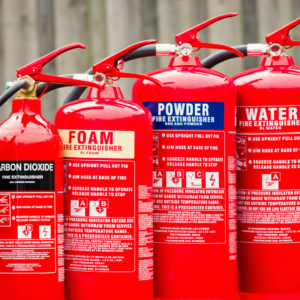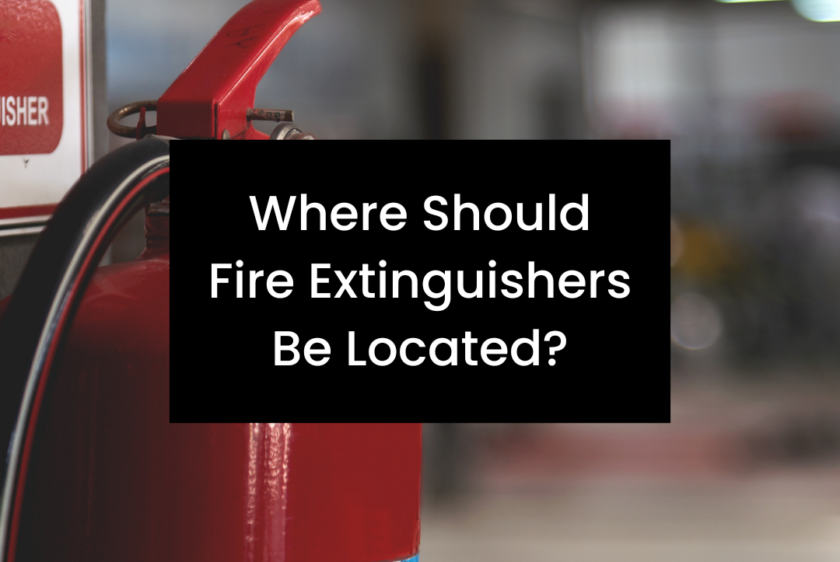As a business owner or office manager, you know you need fire extinguishers throughout your facility, but where should fire extinguishers be located? DynaFire knows! And we’re here to ensure that your fire extinguishers are strategically placed and maintained to meet all safety standards and regulations.
Ensuring the safety of your workplace against fire hazards involves more than just having fire extinguishers on hand—it’s about strategically placing them to maximize accessibility and effectiveness in an emergency.
Understanding fire extinguishers’ proper placement and spacing is crucial for businesses aiming to enhance their fire safety protocols. Here, we explore essential guidelines and considerations for positioning fire extinguishers in your facility, ensuring readiness to combat fires swiftly and safely.
Critical Purpose of Fire Extinguishers
When used correctly, fire extinguishers are essential tools for initial fire response. They are indispensable in controlling small fires before they escalate, provided they are readily accessible and adequately maintained.
According to OSHA regulations [29 CFR 1910.157(c)], fire extinguishers must be strategically placed throughout all workplace areas, ensuring no space is left unprotected. This proactive approach aligns with regulatory requirements and enhances your organization’s overall safety preparedness.
Fire Extinguishers Location Based on Fire Risk
When answering the question, “Where should fire extinguishers be located,” you should first place them where the fire risk is most likely or could spread rapidly. Common locations include hallways, meeting rooms, kitchens, mechanical and electrical rooms, and near exit doors. These placements ensure fire extinguishers are easily accessible during an emergency, minimizing response time and reducing potential damage.
Potential fire hazards present in specific areas of your facility dictate the required size and type of fire extinguisher needed. Understanding the classification of fire types (Class A, B, C, D, and K) and their corresponding fire extinguisher requirements is crucial.
Each class demands specific extinguishing agents and deployment distances, as NFPA and OSHA standards outline. Proper assessment and compliance with these guidelines ensure your fire protection strategy is tailored to your environment’s unique needs and risks.
Where Should Fire Extinguishers Be Located?
Properly locating fire extinguishers within your facility is vital for effective fire response and compliance with safety regulations. The placement should consider various factors, including the types of hazards present, the size and layout of the building, and the accessibility needed in an emergency.
Follow this guide to the proper placement of your fire extinguishers:
Identify Fire Hazard Areas: Identify areas where fire hazards are most likely to occur. These are places where flammable materials are used, stored, or processed. Examples include kitchens, mechanical rooms, electrical rooms, storage areas for flammable liquids or gases, and areas with equipment that generates heat.
Apply NFPA Guidelines: Follow the guidelines set forth by the NFPA for the placement of fire extinguishers based on the types of fire hazards present:
- Class A Hazards (Combustible materials like wood, paper, and cloth): Ensure fire extinguishers are no more than 75 feet away and have at least one 2:A extinguisher for every 3,000 square feet in offices and assembly halls.
- Class B Hazards (Flammable liquids and gases): Place fire extinguishers within 50 feet of potential hazards, with sizes and numbers determined by each area’s specific flammability risks. For instance, areas with light hazards might require a 5:B extinguisher every 30 feet, while high-hazard areas may need a 40:B extinguisher every 30 feet.
- Class C Hazards (Energized electrical equipment): These areas require fire extinguishers that can handle Class A or B fires as well, placed based on the respective hazard level.
- Class D Hazards (Combustible metals): Install Class D fire extinguishers within 75 feet of the hazard, as specified by NFPA standards.
- Class K Hazards (Combustible cooking media): Ensure fire extinguishers are within 30 feet of cooking equipment using oils and fats, with specific guidelines under NFPA 10.
Address Accessibility and Visibility: Place fire extinguishers in easily accessible locations that are clearly visible and unobstructed. They should be mounted on walls or placed in cabinets at heights appropriate for their weight, ensuring their handles are reachable for all users.
Remember Special Considerations: Consider additional factors such as the building layout, occupancy type, and barriers or potential obstructions that could hinder access during an emergency. Regularly review and update the placement of extinguishers based on changes in your facility’s layout or operations.
By adhering to these guidelines and working with a professional fire safety provider like DynaFire, you can ensure your facility is well-equipped to handle fire emergencies effectively.
Installation and Maintenance
Installing fire extinguishers correctly is as important as selecting the right type and quantity. They should be mounted securely on brackets or wall cabinets, with their carrying handles positioned at optimal heights for easy access.
Regular maintenance and inspections are essential to verify that fire extinguishers are fully charged, visible, and free from damage or obstruction. This proactive approach ensures compliance with safety regulations and enhances the reliability and effectiveness of your fire safety infrastructure.
DynaFire: Your Partner in Fire & Life Safety Solutions
At DynaFire, we specialize in comprehensive fire safety solutions designed to safeguard businesses and organizations. Our services encompass every aspect of fire extinguisher management, from initial consultation and assessment to installation, testing, and ongoing maintenance.
By partnering with DynaFire, you gain access to:
- Expert Consultation: Our team evaluates your facility to recommend the most suitable fire extinguisher types and placements based on regulatory standards and specific fire hazards.
- Professional Installation: We ensure fire extinguishers are installed correctly and securely, adhering to NFPA and OSHA guidelines to optimize accessibility and functionality.
- Routine Maintenance: DynaFire conducts regular inspections and maintenance checks to ensure that all fire extinguishers remain in optimal operating condition and are ready to respond effectively in emergencies.
Contact DynaFire Today
Proper placement and maintenance of fire extinguishers are vital for workplace safety and regulatory compliance. Following best practices and partnering with DynaFire can enhance your organization’s readiness to respond to fire emergencies swiftly and effectively.
Take proactive steps today to protect your employees, property, and business continuity. Contact DynaFire if you’re wondering where should fire extinguishers be located. Learn more about our fire extinguisher services and schedule a consultation tailored to your fire safety needs.






